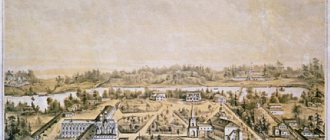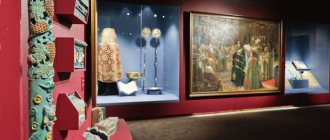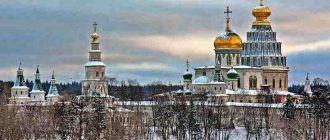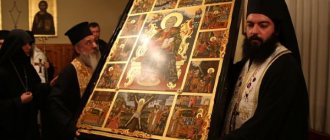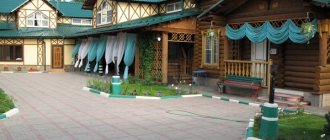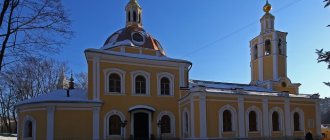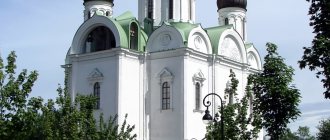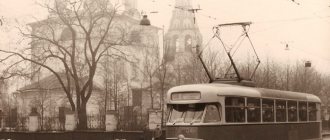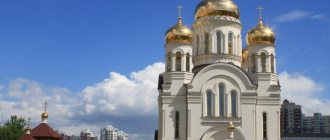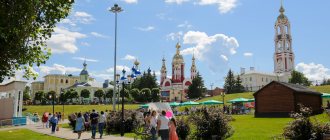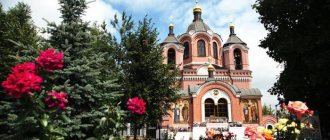Mir
Russia Moscow region Sergiev Posad Gethsemane Chernigov monastery Map loading in progress...
{"format":"leaflet","minzoom":false,"maxzoom":false,"limit":50,"offset":0,"link":"all","sort":[""], "order":[],"headers":"show","mainlabel":"","intro":"","outro":"","searchlabel":"\u2026 \u0441\u043b\u0435\ u0434\u0443\u044e\u0449\u0438\u0435 \u0440\u0435\u0437\u0443\u043b\u044c\u0442\u0430\u0442\u044b","default":"","import-annotation":false,"width ":"auto","height":"350px","centre":{"text":"","title":"""link":"","lat":56.3080489999999969086275086738169193267822265625,"lon": 38.179563000000001693479134701192378997802734375,"icon":""},"title":"","label":"","icon":"","lines":[],"polygons":[],"circles":[ ],"rectangles":[],"copycoords":false,"static":false,"zoom":8,"defzoom":14,"layers":["OpenStreetMap"],"image layers":[] ,"overlays":[],"resizable":false,"fullscreen":true,"scrollwheelzoom":true,"cluster":false,"clustermaxzoom":9,"clusterzoomonclick":true,"clustermaxradius":80, "clusterspiderfy":true,"geojson":"","clicktarget":"","showtitle":true,"hidenamespace":false,"template":"","userparam":"","activeicon": "","pagelabel":false,"ajaxcoordproperty":"","ajaxquery":"","locations":[{"text":"\u003Cb\u003E\u003Ca href=\"/palomnik/%D0% 93%D0%B5%D1%84%D1%81%D0%B8%D0%BC%D0%B0%D0%BD%D1%81%D0%BA%D0%B8%D0%B9_%D0%A7% D0%B5%D1%80%D0%BD%D0%B8%D0%B3%D0%BE%D0%B2%D1%81%D0%BA%D0%B8%D0%B9_%D1%81%D0% Ba%d0%b8%d1%82 \ "title = \" \ u0413 \ u0435 \ u0444 \ u0441 \ u0438 \ u043c \ u0430 \ u043d \ u0441 \ u043a \ u0438 \ u0439 \ u0427 \ u0435 \ u0435 \ u0435 \ u0435 \ u0435 \ u0435 \ u0435 \ u0435 \ u0435 \ u043 is 440 \ U043D \ U0438 \ u0433\u043e\u0432\u0441\u043a\u0438\u0439 \u0441\u043a\u0438\u0442\»\u003E\u0413\u0435\u0444\u0441\u0438\u043c\u0430\u043d\u 0441\u043a\u0438\u0439\ u0427\u0435\u0440\u043d\u0438\u0433\u043e\u0432\u0441\u043a\u0438\u0439 \u0441\u043a\u0438\u0442\u003C/a\u003E\u003C/b\u003E \u003Chr /\u003E\u003Ca href=\"/palomnik/%D0%A1%D0%B2%D0%BE%D0%B9%D1%81%D1%82%D0%B2%D0%BE:%D0%90%D0%BD%D0 %BD%D0%BE%D1%82%D0%B0%D1%86%D0%B8%D1%8F\" title=\"\u0421\u0432\u043e\u0439\u0441\u0442\u0432\u043e:\ u0410\u043d\u043d\u043e\u0442\u0430\u0446\u0438\u044f\»\u003E\u0410\u043d\u043d\u043e\u0442\u0430\u0446\u0438\u044f\u003C/a\ u003E:\u044f\u0432 - \u0422\u0440\u043e\u0438\ u0446\u043a\u043e\u0439 \u0421\u0435\u0440\u0433\u0438\u0435\u0432\u043e\u0439 \u041b\u0430\u0432\u0440\u044b","title":"\u0413\u0 435\u0444\u0441 \u0438\u043c\u0430\u043d\u0441\u043a\u0438\u0439 \u0427\u0435\u0440\u043d\u0438\u0433\u043e\u0432\u0441\u043a\u0438\u0439 \ u0441\u043a\u0438\u0442", "link":"","lat":56.3080489999999969086275086738169193267822265625,"lon":38.179563000000001693479134701192378997802734375,"icon":""}]" imageLayers":[]}
56.315311; 38.135972
Russia, Moscow region, Sergiev Posad
Sergiev Posad, Moscow region
Russia
Telephone:
+7 496 549 25 28, (call from 8:30 to 17:00)
Email:
Gethsemane Chernigov monastery
is the courtyard of the Holy Trinity Sergius Lavra. The monastery was founded in 1844 by the abbot of the Holy Trinity Sergius Lavra, Rev. Anthony (Medvedev), with the active participation of St. Philaret (Drozdov). In April 2016, the Gethsemane Chernigov monastery acquired the status of a cultural heritage site of federal significance.
History[[edit]h2>
In 1844, through the diligence of St. Philaret (Drozdov), Metropolitan of Moscow and Kolomna, and the abbot of the Lavra, St. Anthony (Medvedev), the beginning of the Gethsemane Chernigov monastery was laid.
Three versts northeast of the monastery of St. Sergius, at a place called Korbukha, in the wilderness of the forest, several monks settled, especially those who were inclined to silence and strict rules. Here, in addition to the usual prayers and sacraments, David’s Psalter was sounded night and day, sanctifying the monastery and those doing good to it.
In the 18th century, monasticism in Rus' underwent the most difficult trials: the Church itself was subordinated to the state, and the penetration of Western philosophical movements thoroughly undermined the authority of the Church in high society. In such conditions, the idea of restoring what was closest to the spirit of the founder of the monastery, St. Sergius of Radonezh, soon found its embodiment through the diligence of the Lavra’s trustee leaders. And already after the organization of the new monastery, not only simple peasant people, but also philosophers, whose teachings found a response among high society, flowed to the pure source of spiritual life.
The first church in the new monastery was an ancient two-story wooden church in honor of the Dormition of the Mother of God, moved from the village. Podsosenye, from the Assumption Monastery located there. At the new location, the temple was consecrated on September 28, 1844. Later, the Refectory Church appeared nearby, two-story, with the Throne in the name of St. Sergius and Nikon of Radonezh on the upper floor (consecrated on September 27, 1853) and with the Throne of Philaret the Merciful on the lower floor (September 27, 1860), a cemetery church in honor of the Resurrection of Christ, consecrated September 27, 1853.
The main holiday in the new monastery began to be considered the third day after the Dormition of the Most Holy Theotokos - after all, it was then that the disciples of the Lord saw Her empty tomb, opened for farewell to the Apostle Thomas, who was late for burial, and then the miracle of the Ascension of the Mother of God from earth to Heaven was revealed.
Saint Philaret, who often stayed at the monastery, says this in a letter to the Monk Anthony, who was the governor of the Lavra at that time: “I bury the celebration in the monastery church of the Sunday closest to the Dormition of the Most Holy Theotokos by the fact that a new private celebration would join the ready-made general holiday... It would be consistent with the history of Gethsemane to celebrate the third day after the Assumption. But there will still be time to judge this.”
With the establishment of the Gethsemane monastery and the establishment of its main holiday, a deep symbolic connection was formed between this monastic monastery, hidden from the noisy city by a dense forest, and the Holy Trinity Lavra of St. Sergius, both with Jerusalem, where the Dormition of the Mother of God took place. The rule laid down by Saint Philaret gave rise to a pious custom, according to which many Orthodox Christians, on the very day of the Assumption, sought to pray in the Lavra, and on the third day they went to the Gethsemane monastery.
One of the main shrines was brought to the monastery by the Orthodox writer and historian Andrei Nikolaevich Muravyov. Two stones were delivered to them from Gethsemane in Jerusalem. Muravyov in his letter to Saint Philaret writes: “What can I tell you about Gethsemane, which is sweet for you? I say for you because you renewed her memory in the Lavra: I will bring to the new Gethsemane two stones with crosses carved on them from the old one: one from the cave of Gethsemane for your upper church and the other from the cave where the Lord prayed for the passage of the Cup - for bottom. Let this remain with you as a memory of sacred places and their unworthy visitor.” One of the stones brought by Andrei Nikolaevich Muravyov in 1850 has survived to this day and remains in the cathedral in honor of the Icon of the Mother of God “Chernigov of Gethsemane”. Under the stone inserted into the icon case, there is an inscription: “Stone taken in Palestine Gethsemane from the tomb of the Mother of God for blessing in northern New Gethsemane.”
In the same 1850, the Muravyovs brought a letter from Patriarch Kirill II of Jerusalem with the blessing of New Gethsemane, which said: “... But what raised our heart to the height of spiritual joy is what was communicated to us by His Excellency A.N. The Muravyovs are pleased to hear that Your Eminence, having extreme reverence for the all-honorable tomb of our Lady Theotokos in the Holy Land and wishing to be more vividly transported in the mind to Holy Gethsemane in Jerusalem, created a church near the holy temple of St. Sergius in honor of the Dormition of the Most Holy Theotokos and, having consecrated it, named it the new Gethsemane ... The most powerful and most Orthodox All-Russian power, now containing in its bosom the new Jerusalem and the new Gethsemane, may it forever preserve its renewed zeal for piety and special reverence for the all-honorable and most venerable places under our Throne, and may it continue to endlessly show its sovereign intercession to the Mother of all Churches and help".
The cave compartment at the monastery owes its appearance to the holy fool Philip (peasant Philip Andreevich Khorev). Having taken upon himself the heavy cross of foolishness, he went on a pilgrimage on foot from the Vladimir province to the Kiev-Pechersk Lavra. What he saw there impressed him so much that upon returning to the monastery of St. Sergius, Philip decided to build caves. Having asked for the blessing of the Monk Anthony to “dig a cellar” for storing food from the refectory at the Gethsemane monastery, the holy fool began to implement his idea. After some time, near the monastery, on a hillock, in St. Isaac's Grove, located across the pond from the monastery, the first underground cells appeared. Having learned about this, the Monk Anthony reported what he had seen to Saint Philaret, and he blessed the undertaking with the words: “May the Lord enlighten those who seek Him in the darkness of the cave.”
Soon the first church appeared in the cave compartment at the Gethsemane monastery. It was also two stories high. The lower temple, located entirely in caves, was consecrated on September 27, 1851 in honor of Archangel Michael. The upper one, above the cave, is in honor of the Venerable Anthony and Theodosius of Kiev-Pechersk (consecrated on July 7, 1857).
From its very construction, the cave department attracted many pilgrims who were eager to see the likeness of the Kiev-Pechersk monastic cells. But even more pious Christians began to flock to this monastery, located in the thicket of the forest, after a wondrous miracle that glorified the miraculous icon of the Mother of God, called the Chernigov Gethsemane.
Initially, the icon of the Mother of God, called the Chernigov Ilyinskaya icon, was donated to the cave temple by the maiden Alexandra Grigorievna Filippova in 1852. The first miracle happened from the image on September 1 (14 according to the new style) 1869, when the peasant woman Fekla Adrianova was completely healed from a serious illness. Since then, many miraculous healings have occurred through prayers in front of the icon.
After the miraculous glorification of the image of the Mother of God, even more pilgrims began to arrive in the cave compartment, and the wooden church could no longer accommodate everyone. Therefore, in 1886 it was decided to build a new stone cathedral. The difficult technical task was entrusted to the engineer-architect Nikolai Vladimirovich Sultanov, who not only brilliantly executed the project in the Russian style, but also, thanks to his engineering skills, preserved the caves intact, building a powerful foundation in very wet soil. Moreover, during the construction of the cathedral, the old wooden church remained undismantled so that services in it, if possible, would not stop. The new majestic cathedral was consecrated on August 26, 1894.
The architectural appearance of the cave branch, which became known as the Chernigov Monastery, was completed at the very beginning of the 20th century, when its territory was surrounded by a powerful and relief brick fence, and a high five-tier bell tower was erected along the central axis with the cathedral, its beauty not inferior to the Lavra. Architect Alexander Afanasyevich Latkov tried to create the fence and bell tower in the same style as the cathedral, which served to create an unusually holistic perception of the entire ensemble, perfectly harmoniously blending into the natural motifs of the coniferous thickets.
Of course, it was not the architecture that glorified the monastery, but its spiritual life. Pilgrims came here not only to pray before the miraculous image of the Mother of God, but also to ask for advice and guidance from the Monk Barnabas.
The rules of the Gethsemane monastery were famous for their severity and spirit of Orthodox zeal. Fasting, constant prayer, a ban on idle talk, monastic solitary living - everything was aimed at the salvation of the human soul.
Where there is severity, there is consolation and affection. The future elder Father Varnava (in the world Vasily Ilyich Merkulov) was born on January 24, 1831 into a family of serfs in the village. Prudishchi, Tula province. Soon the family was sold to the landowner Skuratov, who transferred them to the village. Narofominskoye (now Naro-Fominsk) near Moscow. The boy was baptized on January 29, on the day of remembrance of the three saints, and was named Basil at Baptism (in honor of St. Basil the Great). During one of his pilgrimages to the Holy Trinity Sergius Lavra, the God-fearing youth decided to enter a monastery. So in 1851, he, together with his confessor, the elder Gerontius, settled in the skete, fulfilling the obedience of a mechanic, psalmist, and guide of pilgrims through the caves of the skete. In 1863, he was entrusted with founding a new communal monastery near the village. Vyksa, Nizhny Novgorod province. On November 27, 1866, on the day of the celebration of the miraculous icon of the Mother of God “The Sign,” the cassock novice Vasily was tonsured into a mantle with the name Barnabas (translated from Hebrew as “son of consolation”) in honor of the apostle Barnabas from the age of 70. Thus began the feat of old age. The Lord noted the Monk Barnabas with the visible gift of insight and healing from mental and physical ailments. People began to flock to him from everywhere, and he refused no one help and edification. Every day he received more than 500 visitors, finding for everyone the necessary words of consolation and reconciliation with God.
The elder reposed in the Lord in the altar of the house church at the Alexander-Mariinsky House of Charity in front of the Holy See in 1906 on February 17 (March 1/2 according to the new style). He was buried in the Iverskaya cave chapel, where during his life he loved to pray. From that moment on, miracles began to happen at his grave and according to his posthumous prayers. In 1995, the Monk Barnabas was glorified as a saint. The old man’s wooden house, in which he received numerous pilgrims, has miraculously survived to this day.
Unfortunately, in the 20s of the last century, even in these remote places the terrible yoke of persecution against the Church came. It was to the Gethsemane monastery that on October 21, 1919, the brethren of the closed Holy Trinity Sergius Lavra were relocated. The monastery itself first experienced the test of the atheistic yoke on August 31, 1918, when the new authorities carried out a search in the monastery with particular audacity. The monastic hostel in the cave section was liquidated in 1921, and the cathedral itself in honor of the Icon of the Mother of God “Chernigov Gethsemane” was finally taken away from the worshipers in 1922. The Gethsemane monastery received the status of an agricultural artel in 1924, and the buildings were transferred to the Moscow Regional Department of Social Security (MOOSO) to house a colony for minors named after Kalyaev and a society for elderly educators. The last Church of the Assumption of the Mother of God, with the transfer of which construction began in a deep forest, was closed in the Gethsemane monastery in 1928. Then it was given over to the deaf-mute club, and after the war the territory of the monastery was transferred to the disposal of the Central Institute of Physics and Technology. The churches were destroyed, and an educational and administrative building was built on the site of the skete cemetery.
Only in 1991, thanks to the diary entries of the writer Mikhail Mikhailovich Prishvin, who often visited the monastery and cave department, it was possible to establish the location of the graves of two of the most famous philosophers of the late 19th - early 20th centuries: Konstantin Nikolaevich Leontyev (in the monasticism of Clement) and his ideological heir Vasily Vasilyevich Rozanov .
In 1944, most of the cave section of the monastery was given over to a vocational boarding school for the disabled. The Cathedral in honor of the Icon of the Mother of God “Chernigov Gethsemane” survived partly due to its size: the new government adapted it for a prison colony, a boarding school, and then for a warehouse of the Zagorsk City Industry and Trade Store. The internal volume was divided into two floors. Part of these ceilings was left after the revival and is now used to house the choir.
The 20th century brought severe trials. Evidence of yet another spiritual desolation is the flooded caves of the Chernigov monastery and desecrated frescoes of saints with chipped faces. It was in this form that the cathedral in honor of the Icon of the Mother of God “Chernigov of Gethsemane” and the bell tower with two churches located in it were returned to the Church.
Architecture
The compositional center of the architectural ensemble of the monastery is the Chernigov Church (1886-1889). Below it is a cave church, built in 1851. In 1856-1857, a spacious refectory of the cave temple with a vaulted ceiling was built, so that the original church of 1851 turns into an altar. The cave church has now been completely restored.
The decision to build a new, already stone, above-cave temple instead of a dilapidated wooden church was made in 1886. Architect N.V. Sultanov was approved as the author of the project and supervisor of the work. The Chernigov Church was completed in rough form in 1889, the lighting of the main altar took place in 1893, finishing was completed only in 1897. It is noteworthy that the entire period of construction the cave church remained active. As of 2007, restoration work is underway in the Chernigov temple.
Current state[[edit]h2>
The return of the monastery to the Church began on September 13, 1989. On the eve of the holiday in honor of the Icon of the Mother of God “Chernigov Gethsemane”, the first meeting of the abbot of the Holy Trinity Sergius Lavra, Archimandrite Theognost (now Archbishop of Sergiev Posad) took place with representatives of the Zagorsk City Executive Committee, and on April 11, 1990, secular authorities decided to gradually transfer the Chernigov monastery to the Lavra.
On July 18, 1990, the monastery was visited by His Holiness Patriarch of Moscow and All Rus' Alexy II. Since then, the revival of this holy place began, both externally and internally, spiritually. The Liturgy is again served in the church, prayers are offered, and much work is being done to restore the former beauty of the monastery.
In his speech at the end of the Divine Liturgy celebrated in the monastery on March 10, 2012, His Holiness Patriarch of Moscow and All Rus' Kirill Fr.
To date, a large amount of architectural and restoration work has been carried out in the cathedral in honor of the Icon of the Mother of God “Chernigovskaya Gethsemane”, the cave churches of the Archangel Michael and the Venerable Anthony and Theodosius of Pechersk have been restored, the bell tower and the churches of St. Nicholas, the Myra of Lycian Wonderworker, and the Saints located in it have been renovated Equal-to-the-Apostles Constantine and Helena, on the shore of the pond a wooden over-chapel has been recreated, in which, even before the revolution, numerous pilgrims collected water from the source.
The monastery complex includes the following buildings:
- Cathedral in honor of the Icon of the Mother of God “Chernigov Gethsemane”
- Temple of the Archangel Michael
- Temple of St. Nicholas, the Wonderworker of Myra of Lycia
- Chapel in honor of the Holy Prince Vladislav of Serbia
- Bogolyubskaya Kinovia with churches in honor of the Bogolyubskaya Icon of the Mother of God and the Holy Blessed Prince Igor of Chernigov
Bogolyubskaya Kinovia
On the shore of the Skete ponds, far from noisy roads, in the depths of the forests, not far from the Gethsemane Chernigov Skete of the Holy Trinity Sergius Lavra in a place called Korbukha, a century and a half ago (in 1858) the blessed schemamonk Philip founded Bogolyubskaya Kinovia (from the Greek “cinnovia” " - "dormitory").
At the very beginning, a two-story church with two altars was built here: in the name of the holy women Matrona and Capitolina on the lower floor and in honor of the Bogolyubskaya Icon of the Mother of God on the upper floor. In this quiet, peaceful place, near a two-story church, a cemetery for the brethren of the Holy Trinity St. Sergius Lavra was established. Schemamonk Philip was buried in the lower church. Several years ago, his honest remains were transferred to the Iveron Chapel of the Skete caves.
Gradually, Kinovia expanded and turned into a large communal monastery. Five wooden cell buildings were built for the brethren, one of which had three floors; behind the fence stood a wooden building of a hospice; maintained its own barnyard. In 1875, a stone two-story refectory building was built on the western edge of the monastery. Between the church and the refectory, the Holy Gates were erected - the main entrance to the territory of Kinovia for pilgrims. To approach the gate, pilgrims had to cross the bay of the monastery pond on a wooden bridge and then climb the steps of a rather steep staircase built along the slope of the hill on which the gate stood. In 1907, Kinovia was surrounded by a stone fence 250 fathoms long.
Unfortunately, even in these remote places in the 20s of the last century the terrible yoke of persecution against the Church came, which destroyed not only most of the buildings in Kinovia, but also the necropolis, the tombstones from which were blasphemously used to pave the road. Kinovia was closed after the revolution on May 2, 1922. All valuables (icons, utensils) were confiscated from the monastery and transferred to the famine relief fund. Then the territory of the monastery became a garment factory.
Only a stone single-domed church in the Old Russian style with a hipped bell tower has survived to this day, which has recently been returned to the jurisdiction of the Russian Orthodox Church.
Repair and restoration work to restore the Church of Bogolyubskaya Kinovia began in 2012. Now, thanks to the efforts of benefactors, the temple has been restored to its former splendor.
The great consecration of the temple in honor of the Bogolyubsk Icon of the Mother of God took place on July 24, 2022.
The great consecration of the temple in honor of the holy noble prince Igor of Chernigov took place in Bogolyubskaya Kinovia on August 30, 2019. The rite was performed by the vicar of the Holy Trinity Sergius Lavra, Bishop of Sergiev Posad Paramon.
Chapel of the Holy Blessed Prince Vladislav of Serbia
Gethsemane Chernigov Skete was founded in 1844. Through the efforts of Schemamonk Philip, a cave section was formed in 1847. Soon after the excavation of the caves, a spring appeared there, at a depth of about 15-20 meters. The brethren used the water from it as well water. After the construction of the cathedral in honor of the Icon of the Mother of God of Chernigov, the Gethsemane treasure was located on the western side of the temple, directly under the porch.
For the convenience of collecting water, a chapel was built, into which numerous pilgrims came to the monastery to pray before the miraculous image of the Mother of God of Chernigov of Gethsemane. After the glorification of the miraculous icon, people began to receive grace-filled help in healing various ailments from the source.
In the twenties of the 20th century, the water drainage system from the underground well was destroyed and all the buildings fell into complete disrepair, and the chapel itself was completely destroyed. According to the Providence of God, through the labors of specialists and the care of pious Orthodox Christians, the water drainage has now been restored, a font has been equipped and a chapel has been built over it in honor of the holy noble prince Vladislav of Serbia. The rite of consecration was performed on September 14, 2016, the day of the glorification of the Icon of the Chernigov Mother of God of Gethsemane. Once again, as in historical times, access to a supply of water is open for consumption for the benefit of soul and body.
The chapel is open from 5:00 to 21:00.
Cave department
The cave department of the Gethsemane monastery was founded in 1847 by the holy fool Philip, or Philippushka, as he is lovingly called in the monastery.
He was born into a peasant family in the Vladimir region.
Subsequently, he left his home, wife and children for the sake of an ascetic life and service to the Lord. He led an ascetic life - he wore old clothes and had no shoes, slept on the ground, and often went hungry. Saint Philip was endowed with extraordinary meekness and the gift of foresight.
Filippushka traveled a lot throughout Rus', visited a huge number of monasteries, and visited Kyiv. It was the Kyiv caves that inspired him to create an underground monastery in Russia. He sought silence, but Bishop Philaret blessed him to live in the Sergius Monastery.
Important! When to read a prayer of thanksgiving to the Lord God
It was too crowded here, so the governor Anthony transferred him to a new monastery. Philip was blessed to “excavate the cellar,” which over time turned into a whole system of underground passages and rooms.
Everyone who wanted to live next to the holy fool dug his own cave. Now you can see cells of different sizes with benches carved from stone, on which their inhabitants, the monks, slept. The Church of the Archangel Michael is decorated with extraordinary paintings, the restoration of which is the merit of modern restorers. There is a healing spring in the caves. Using a pump, the monks extract water from it, which they distribute to pilgrims. The water has an unusually mild taste.
Activities of the monastery[[edit]h2>- Sunday School
- Confectionary shop
At the Gethsemane Chernigov monastery there is a small confectionery shop that provides delicious baked goods not only to the brethren, but also to parishioners. We offer Easter cakes and Easter cakes made by our confectionery shop (chocolate Easter, with boiled condensed milk, with candied fruits, with raisins, with nuts, with prunes, with almonds). The shop's assortment includes not only ordinary pies with a wide variety of fillings, but also wonderful cakes that can decorate any holiday table. During Lent, vegetable fats are used to make cakes, dough and cream. A wide variety of breads and kvass are made according to ancient recipes. All bread is made without the use of yeast.
Architecture
The compositional center of the architectural ensemble of the monastery is the Chernigov Church (1886-1889). Below it is a cave church, built in 1851. In 1856-1857, a spacious refectory of the cave temple with a vaulted ceiling was built, so that the original church of 1851 turns into an altar. The cave church has now been completely restored.
The decision to build a new, already stone, above-cave temple instead of a dilapidated wooden church was made in 1886. Architect N.V. Sultanov was approved as the author of the project and supervisor of the work. The Chernigov Church was completed in rough form in 1889, the lighting of the main altar took place in 1893, finishing was completed only in 1897. It is noteworthy that the entire period of construction the cave church remained active. As of 2007, restoration work is underway in the Chernigov temple.
The southern cell building was built between 1861-1865, and the second floor was completed in 1870. After the construction of a two-story refectory building along the western fence in 1889, all new buildings in the monastery are maintained in the pseudo-Russian style, in stylistic unity with the Chernigov temple. In 1894, the monastery fence was built, and in 1895, A. A. Latkov erected a five-tier bell tower, almost equal in height to the Lavra, opposite the eastern facade of the Chernigov Church. In 1904, a cell building was built along the eastern fence.
Shrines[[edit]h2>- The miraculous Chernigov-Gethsemane image of the Mother of God.
On September 1, 1869, on the day of the church new year, the Chernigov Icon of the Mother of God, given as a contribution to the Cave Church, shone in the Skete. A paralyzed peasant woman who had suffered from her illness for nine years was healed. From that moment on, over 100 miracles and healings emanating from this icon were recorded. Many sick people rushed to the Skete and venerated the miraculous image. They asked to send oil from the lamp by mail, they ordered prayers in absentia, they even prayed before the image of the icon in books - and everyone was heard, everyone received help. Copies of the miraculous image of the Mother of God have spread everywhere and are venerated in many Orthodox churches. It is no coincidence that the prototype of this icon was found by St. Anthony of Pechersk, the founder of Russian monasticism and the first Russian cave dweller. - Golgotha with a particle of the Tree of the Life-Giving Cross of the Lord
- Stone from the tomb of the Mother of God, brought from Jerusalem in 1850 for the blessing of the new Northern Gethsemane
- Icon of the Mother of God “The Unbreakable Wall”
- Icon of the Mother of God All-Tsaritsa - blessing of Holy Mount Athos, gift of the Vatopedi monastery
- Reliquary with pieces of the relics of the Kiev-Pechersk and other saints
- Holy relics of St. Barnabas of Gethsemane
- Miraculous spring
- Icons with particles of relics: Icon of the Holy Blessed Matrona of Moscow
- Icon of the holy noble princes of Murom Peter and Fevronia
- Icon of St. Nicholas
- Icon of St. Sergius of Radonezh
- Icon of the Venerable Prince Oleg of Bryansk
- Icon of the Holy Blessed Prince Andrei Bogolyubsky
- Icon of St. Maximus the Greek
On September 1, 1869, on the day of the church new year, the Chernigov Icon of the Mother of God, given as a contribution to the Cave Church, shone in the Skete. A paralyzed peasant woman who had suffered from her illness for nine years was healed. From that moment on, over 100 miracles and healings emanating from this icon were recorded. Many sick people rushed to the Skete and venerated the miraculous image. They asked to send oil from the lamp by mail, they ordered prayers in absentia, they even prayed before the image of the icon in books - and everyone was heard, everyone received help. Copies of the miraculous image of the Mother of God have spread everywhere and are venerated in many Orthodox churches. It is no coincidence that the prototype of this icon was found by St. Anthony of Pechersk, the founder of Russian monasticism and the first Russian cave dweller.
Interior decoration
The interior decoration of the Church of the Mother of God of Chernigov-Gethsemane amazes with its grandeur and beauty. Superbly executed frescoes, icons in expensive frames, a painted vaulted ceiling with images of the most revered saints, a shrine with the relics of St. Barnabas - at the sight of all this, your heart skips a beat, you want to speak in a whisper and turn to the Lord only with the most pressing problems.
At the entrance to the Temple, headscarves and skirts are offered; it is considered a sin for women to enter with their heads uncovered and in trousers. The underground cave temple is quite ascetic inside. There are also many icons here, the faces of saints look out from all the walls.
But everything was done in a simple and austere style, recalling that monks lived here in the harshest conditions, the strictest fasting and constant deprivation, whose whole life consisted of incessant prayers and self-torture. The vaulted walls in the corridors and cells are painted with ancient Russian ornaments, the floor is lined with thick tiles.
Chernigov Skete of Gethsemane in Sergiev Posad inside.
The perimeter of the monastery is surrounded by a red-brick wall of thick 0.5-meter masonry, with towers in the corners. The area is well-groomed, clean, divided into lawns, surrounded by fragrant flower beds. There are signs, warnings and explanatory signs everywhere.
In front of the gates of the monastery, the waters of the Gethsemane ponds, which once separated the Chernigov monastery from the Gethsemane monastery, glisten under the sun. Swans and ducks swim here, which visitors love to feed.
On the territory of the monastery there are two refectory-cafes, where monastic food, delicious pastries, aromatic and invigorating, yeast-free kvass, brewed using the monastery’s own technology, are offered. There is pine, spicy ginger, beet kvass.
In the church shop you can buy icons, blessed crosses and silver rings with the inscription “Save and Preserve.” They also sell gold wedding rings with words of protective prayer applied to the inner surface. The church shop accepts orders for tours of the caves. There is a stall with souvenirs.
Patronal holidays[[edit]h2>- Icon of the Blessed Virgin Mary “Chernigov-Gethsemane”
- September 14 - Barnabas of Gethsemane (Merkulov), reverend
- July 19, September 13 - Trinity Day
- 50th day after Easter - Michael, Archangel
- September 19 (memory of the miracle in Khoneh), November 21 (cathedral) - Nicholas the Wonderworker, Archbishop of Myra, Saint
- May 22, December 19 - Vladislav of Serbia, noble prince
- October 7 - Icon of the Most Holy Theotokos “Bogolyubskaya”
- July 1 - Igor Chernigovsky, noble prince
- June 18, October 2
- September 14
- July 19, September 13
- 50th day after Easter
- September 19 (memory of the miracle in Khoneh), November 21 (cathedral)
- May 22, December 19
- October 7
- July 1
- June 18, October 2
Interesting facts and legends
Interesting facts that have become legends in the history of the monastery over many years:
- Nicholas II personally came to Barnabas of Gethsemane (canonized in 1995). They talked for a long time in private. They say that Barnabas then predicted a painful death for him and his entire family and the death of the Romanov royal dynasty.
- They say that the Chernigov monastery and the Gethsemane monastery were once connected by an underground passage dug by monks and giving them the opportunity to freely go to the Chernigov monastery to worship in the cave temple.
- Parishioners, who came to the monastery not for the first time, claim that the number of angels surrounding the Mother of God in the “Unbreakable Wall” icon is gradually increasing, the holy faces seem to appear on the icon. No one can reliably confirm this miracle, but everyone looks carefully at the icon and tries to count the angels.
- The paths to the Skete are lined with tombstones from the old skete necropolis, destroyed under the Bolsheviks.
How to get there[[edit]h2>
Address:
141307 Moscow region, Sergiev Posad, st. Ponds of Gethsemane, 1
Skeet's Office:
Telephone:
+7 496 549 25 28, (call from 8:30 to 17:00)
Email:
Directions:
The Gethsemane Chernigov monastery is located on the eastern outskirts of Sergiev Posad, Moscow region, 3 km from the Lavra between the villages of Ferma and Kinovia.
You can get from Moscow to Sergiev Posad by suburban bus No. 388 (VDNKh metro station) or by train (from Yaroslavsky station), from Sergiev Posad station to the monastery - by road:
Bus No. 38
About once an hour: 5:45, 6:50, 7:50, 9:05, 10:50, 11:55, 13:10, 14:30, 15:30, 16:36, 17:36, 19 :05, 20:10, 21:15. Get off after 15 minutes at the stop “ul. Kalyaevskaya".
Minibuses and buses to the village. Farm (No. 7, No. 18), Vine (No. 30), No. 36, No. 37
Get off at the entrance to Ferma (checkpoint stop), cross the road and move along the street. Sunny to the north.
By car
From the Lavra - from Red Army Avenue along the street. Karl Marx, then Vifanskaya (2nd turn left with the sign after the railway crossing) and Novogorodnaya to the “NIIRP” sign to turn right.
On the north-eastern side of the monastery there is parking for large tourist buses.
For more details, visit the website
Pilgrim[[edit]h2>
Schedule of services[[edit]h3>
The current schedule of services is presented on the official website of the monastery
Refectory[[edit]h3>
For pilgrimage groups, meals are provided at the “Pilgrim’s Meal”, which is located at the entrance gate. The new refectory has a barrier-free environment for groups of citizens with limited mobility, as well as everything for a comfortable stay for parents with small children: there are tables for feeding children, a changing table. In the new refectory, which can accommodate up to 60 people, you can not only purchase baked goods or prepared products, but also order breakfasts, a set lunch or a funeral meal. Meals can be ordered in advance by telephone.
On the territory of the Gethsemane Chernigov Skete, the “Monastery Meal” is open daily from 8:00 to 20:00. From Thursday to Sunday from 10:00 to 18:00 the “Monastery Meal” is open at the bell tower.
In the refectory you can also order and purchase monastery products.
Details on the website
Unction in the Chernigov Gethsemane monastery
Unction is a religious sacrament, during which holy grace is invoked on a person through anointing with sacred oil - oil. Unction helps to get rid of various illnesses, both physical and mental, and also to forgive sins.
No special preparation is needed for the process of unction. It is advisable to confess and receive communion 3 days before the sacrament (or within three days after). The sacrament is performed starting from the age of 7.
Unction in the Chernigov Gethsemane monastery is held every day (except Sundays and days of religious holidays). Unction begins at 12 o'clock. It is better to arrive at the church approximately 30 minutes before.
